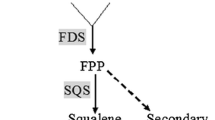Abstract
The translation elongation factor EF-1α appears to play a major role in the control of cell proliferation and ageing in higher eukaryotes. Here we report the cloning of the TEF1 gene encoding the elongation factor 1α of the dimorphic yeast Arxula adeninivorans Ls3. The gene is localized on chromosome 2 from Arxula adeninivorans, comprises 1380 bp and encodes a protein containing 459 amino acids. In contrast to other fungi, a second TEF gene encoding an identical, or nearly identical, polypeptide could not be identified. The transcriptional activity of the TEF1 gene did not change during mycelial growth, whereas a slight decrease could be detected during the yeast growth.
Similar content being viewed by others
References
Birnboim HC, Doly J (1979) A rapid alkaline extraction procedure for screening recombinant plasmid DNA. Nucleic Acids Res 7:1513–1523
Breathnach J, Chambon A (1981) Organization and expression of eukaryotic split genes coding for proteins. Annu Rev Biochem 50:349–383
Cavallius J, Rattan SIS, Clark BFC (1986) Changes in activity and amount of active elongation factor 1α in aging and immortal human fibroblast cultures. Exp Geront 21:149–157
Cottrelle P, Thiele D, Price V, Memet S, Micoun J, March J, Buhler J, Sentenac A, Fromageot P (1985) Cloning, nucleotide sequence, and expression of one of two genes coding for yeast elongation factor 1 alpha. J Biol Chem 260:3090–3096
Davis E, Larkins EA, Knight RH (1972) Polysomes from peas. An improved method for their isolation in the absence of ribonuclease inhibitors. Plant Physiol 50:581–584
Dever T, Glynias MJ, Merrick WC (1987) GTP-binding domain: three consensus sequence elements with distinct spacing. Proc Natl Acad Sci USA 84:1814–1818
Gienow U, Kunze G, Schauer F, Bode R, Hofemeister J (1990) The yeast genus Trichosporon spec. LS3: molecular characterization of genomic complexity. Zbl Mikrobiol 145:3–12
Gurr SJ, Unkles SE, Kinghorn JR (1987) In: Kinghorn JR (ed) Gene structure in eukaryotic microbes. IRL Press, Oxford, pp 93–139
Hanahan D (1983) Studies on transformation of E. coli with plasmids. J Mol Biol 166:557–580
Henikoff S, Kelly JD, Cohen EH (1983) Transcription terminates in yeast distal to a control sequence. Cell 33:607–614
Kunze G, Kunze I (1994) Characterization of Arxula adeninivorans strains from different habitats. Ant van Leeuwenhoek 65:29–34
Kunze G, Bode R, Schmidt H, Samsonova IA, Birnbaum D (1987) Identification of a lys2 mutant of Candida maltosa by means of transformation. Curr Genet 11:385–391
Ledeboer AM, Edens L, Maat J, Visser C, Bos JW, Verrips CT, Janowicz Z, Eckart M, Roggenkamp R, Hollenberg CP (1985) Molecular cloning and characterization of a gene coding for methanol oxidase in Hansenula polymorpha. Nucleic Acids Res 13:3063–3082
Linder P (1992) Molecular biology of translation in yeast. Ant van Leeuwenhoek 62:47–62
Linz E, Sypherd PS (1987) Expression of three genes for elongation factor 1α during morphogenesis of Mucor racemosus. Mol Cell Biol 7:1925–1932
Middelhoven WJ, Hoogkamer-Te Niet MC, Kreger van Rij NJW (1984) Trichosporon adininovorans sp. nov., a yeast species utilizing adenine, xanthine, uric acid, putrescine and primary n-alkylamines as the sole source of carbon, nitrogen and energy. Ant van Leeuwenhoek 50:369–378
Middelhoven WJ, de Jong IM, de Winter M (1991) Arxula adeninivorans, a yeast assimilating many nitrogenous and aromatic compounds. Ant van Leeuwenhoek 60:129–137
Rao TR, Slobin LI (1988) The stability of mRNA for eukaryotic elongation factor Tu in friend erythroleukemia cells varies with growth rate. Mol Cell Biol 8:1085–1092
Rose MD, Winston F, Hieter P (1990) Methods in yeast genetics. A laboratory manual. Cold Spring Harbor Laboratory, Cold Spring Harbor, New York
Roth WW, Bragg PW, Corrias MV, Reddy NS, Dholakia JN, Wahba AJ (1987) Expression of a gene for mouse eukaryotic elongation factor Tu during murine erythroleukemic cell differentiation. Mol Cell Biol 7:3929–3936
Sambrook J, Fritsch EF, Maniatis T (1989) Molecular cloning: a laboratory manual, 2nd edn. Cold Spring Harbor Laboratory, Cold Spring Harbor, New York
Shepherd JCW, Walldorf U, Hig P, Gehring WG (1989) Fruitflies with additional expression of the elongation factor EF-1α live longer. Proc Natl Acad Sci USA 86:7520–7521
Sherman F, Fink GR, Hicks JB (1986) Methods in yeast genetics. Cold Spring Harbor Laboratory, Cold Spring Harbor, New York
Silar P, Picard M (1994) Increased longevity of EF-1α high-fidelity mutants in Podospora anserina. J Mol Biol 235:231–236
Smith CL, Klo S, Cantor CR (1988) In: Davis K (ed) Genome analysis, a practical approach. IRL Press, Oxford, pp 41–72
Stoltenburg R, Wartmann T, Kunze I, Kunze G (1995) Reliable method to separate free and membrane-bound polysomes from different yeast species. Bio/Techniques 18:564–568
Sundstrom P, Smith D, Sypherd P (1990) Sequence analysis and expression of the two genes for elongation factor 1α from the dimorphic yeast Candida albicans. J Bacteriol 172:2036–2045
Tatsuka M, Mitsui H, Wada M, Nagata A, Nojima H, Okayama H (1992) Elongation factor-1α gene determines susceptibility to transformation. Nature 359:333–336
Van der Walt JP, Smith MT, Yamada Y (1990) Arxula gen. nov. (Candidaceae), a new anamorphic, arthroconidial yeast genus. Ant van Leeuwenhoek 57:59–61
Vijgenboom E, Nilsson L, Bosch L (1988) The elongation factor EF-Tu from E. coli binds to the upstream activator region of the TufA-TufB operon. Nucleic Acids Res 16:10183–1097
Wartmann T, Krüger A, Adler K, Bui MD, Kunze I, Kunze G (1995) Dimorphism of the thermoresistant yeast Arxula adeninivorans Ls3. Ant van Leeuwenhock (in press)
Author information
Authors and Affiliations
Additional information
Communicated by K. Wolf
Rights and permissions
About this article
Cite this article
Rösel, H., Kunze, G. Cloning and characterization of a TEF gene for elongation factor 1α from the yeast Arxula adeninivorans . Curr Genet 28, 360–366 (1995). https://doi.org/10.1007/BF00326434
Received:
Issue Date:
DOI: https://doi.org/10.1007/BF00326434




